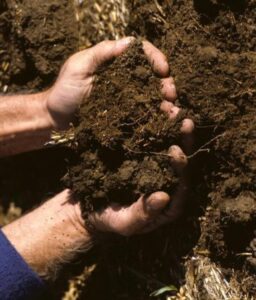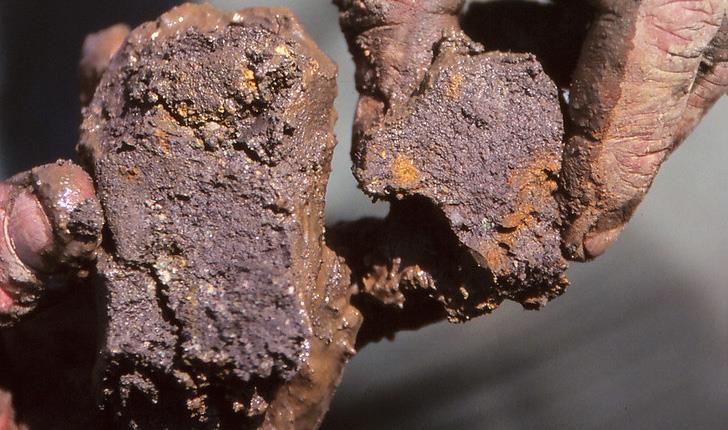Plants also need to eat. If they are well-nourished, the farmer will reap rich harvests, enabling him to feed the population. The best way to see what your crops need, is to take soil samples and have them analysed, and to obtain advice from an agronomist.
Plant nutrient requirements
Plants are made up of ninety different chemical elements. Table 1 lists the sixteen most important elements in plant nutrition, which are called essential elements. The atmosphere provides the first three of these, and the others are provided by the soil.

Table 1: The sixteen essential nutrients for plant production.
The following three, the macronutrients, are needed in large quantities and are also known as major or primary nutrients. The next three are known as secondary nutrients, as they are also needed in relatively large quantities (but less than the macronutrients).
The last seven nutrients are only needed in very small quantities and are known as trace elements or micronutrients. An important distinction must be made between the total quantity of nutrients present in the soil and the quantity available to the plant. Relatively large quantities of many nutrients may be present in the soil but may be unavailable to the plant. Phosphorus, for example, may be present in large quantities in the form of iron phosphate or aluminium phosphate, but as these compounds are virtually insoluble, the phosphorus is not available to the plant.
Some elements are easily transported by the plant from one of its parts to the other, while others cannot be moved once they are fixed to make up the structure of the plant. This is important, as poor, older plant leaves might be an indication of a deficiency of one or more transportable elements, while very poor, young leaves could be an indication of a deficiency of nontransportable elements.

Nitrogen is taken up by the plant, mostly in the form of nitrate. It plays a major role in the process of photosynthesis, and is therefore important for plant growth. The most noticeable effect of nitrogen is the characteristic green colour of leaves. This element can move easily within the plant.
Nitrogen deficiency is noticed in yellowish leaves. Phosphorus is largely taken up in the form of phosphate, and plays an important role in photosynthesis and plant growth. It is equally important for root development, respiration, flowering, and fruit maturation. Phosphorus deficiency causes a purplish colouration at the seedling stage, with later yellowing, stunted growth, and delayed maturity.
Only 25% of all phosphorus added as fertiliser is taken up, while the remainder is fixed in unavailable chemical compounds in the soil. Potassium is not found in plant structures as such, but only in cell fluids. It is essential in all cells for metabolic processes, and also in the opening and closing of leaf pores (stomata).
Furthermore, this macronutrient plays a major role in root development and therefore in the uptake of other elements as well. Potassium affects both respiration and transpiration. It also promotes the synthesis and translocation of carbohydrates, strengthening of plant fibre and cell wall strength. A deficiency causes yellowing of leaf tips and margins.

Calcium forms part of the cell wall structure and is necessary for the growth of cell tissue. It increases the resistance of roots to toxic conditions in acid soils. A deficiency leads to malformation of the growing parts, but symptoms are seldom recognised in the field. Deficiencies are first visible in new and young leaves, due to the relative immobility of calcium in the plant.
Magnesium is crucial to the green colour of plant leaves, without which photosynthesis cannot take place. Shortages can be expected in sandy, acid soils. A deficiency causes discolouration and premature defoliation of the plants. The first deficiency symptoms occur in the older leaves.
Sulphur makes up a part of some amino acids that build up proteins. It promotes the formation of chlorophyll (leaf green) as well as root nodules on legumes.
Iron plays a role in oxidation reduction processes and in chlorophyll formation. It is found in enzymes and certain proteins. It is not very mobile in the plant. Deficiencies occur in alkaline soils. Copper is found in seeds and growing parts of plants, and plays a regulating role in certain plant processes, such as chlorophyll functions and the uptake of iron.
Zinc activates enzymes, regulates the pH of the cell solution, plays a role in chlorophyll, growth hormones and catalyses in certain plant reactions. Zinc deficiencies can be induced by high soil pH or high soil phosphorus levels. Deficiencies reduce the size, structure, and development of plant cells. Zinc is not very mobile in plants.
Manganese plays a role in photosynthesis and in oxidation reduction processes in the plant. It assists in the uptake of nitrates, and enzyme activity. Manganese is not very mobile in the plant.
Boron is essential in pollination and the formation of flowers and fruits. It also plays a role in the uptake of other elements, the synthesis of proteins, and in carbohydrate and water metabolism. Boron deficiency can be expected in leached sandy soils with extremely high or low pH values.
Molybdenum plays an important role in the process of photosynthesis as well as protein formation. Furthermore, it is vital to nodule development for the functioning of nitrogen, fixing bacteria in the roots of legumes. Deficiency symptoms may occur in leached and acid soils.
Chlorine is responsible for regulating the osmotic pressure in plants. A deficiency gives a wilting appearance and “bronzing” of leaves.

Table 2: Optimum soil phosphorus, potassium, calcium, and magnesium values in ppm for a variety of crops.
Optimum soil values for a variety of crops
The soil content of any nutrient or element is expressed as parts per million (ppm), which means the same as milligram per kilogram (mg/kg). If the calcium content is, for example, 250 ppm, it means that 1 kilogram of soil contains 250 milligrams of calcium.
Phosphorus
Namibian soils are very poor in plant-available phosphorus, with typical values of 1 to 5 ppm. It is almost invariably necessary to apply phosphorus when establishing a new crop. The phosphorus should be incorporated into the soil at the determined depth before planting the crops. Phosphorus is not very mobile in soil and subsequent applications should also be applied as close to the roots as possible. If there is too much calcium in the soil, one should use mono-ammonium phosphate or diammonium phosphate rather than superphosphate as a source of phosphate.

Calcium, magnesium, and potassium
Most Namibian soils have more than enough calcium, but may lack magnesium and potassium. These can be applied in the form of dolomitic lime or magnesium sulphate and potassium chloride, sulphate, or nitrate.
Apart from the absolute concentrations of soil nutrients, their relative proportions are also important. It may turn out that the soil has enough magnesium and potassium in absolute terms, but the calcium concentration is so high that it interferes with the plant’s assimilation of these nutrients.
The information in this article is credited to the Namibia Agricultural Union and Namibia National Farmers Union who published the Crop Production Manual in 2008.









